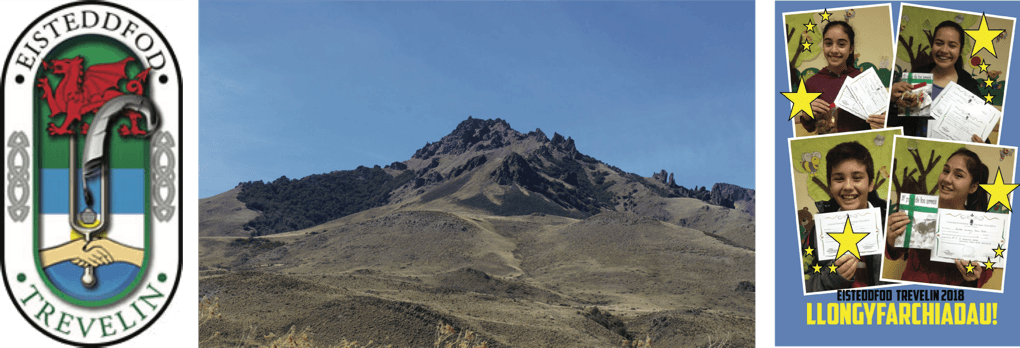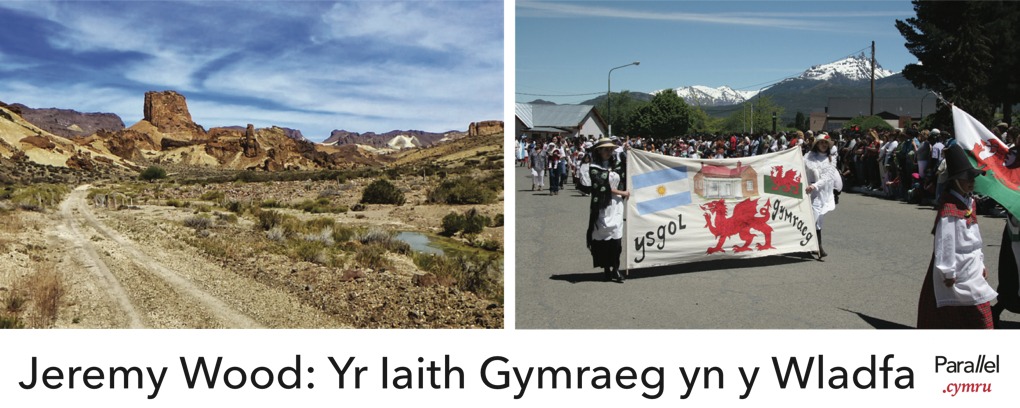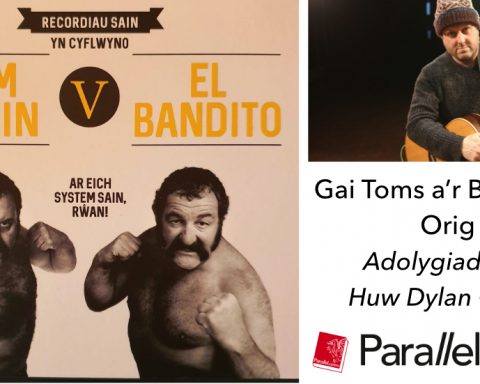Mae Eisteddfodau’n cael eu cynnal ledled cymunedau Cymraeg ym mhedwar ban y byd, ac un ohonyn nhw sy wedi bodoli am gyfnod tra hir, ac sy’n denu llawer iawn o gystadleuwyr, o’i chymharu â’r lleill, yw Eisteddfod Trevelin ym Mhatagonia. Yma, mae Gwion o Ysgol y Cwm yn sôn wrthym ni am ychydig o’i chystadlaethau a’i thraddodiadau, ac rydym ni’n cyflwyno gwaith cyfieithu buddugol gan Alwen Green.
Eisteddfods are held throughout Welsh-speaking comunities all around the world, and one of the longest-running and well-contested is that of Trevelin in Patagonia. Here Gwion of Ysgol y Cwm talks us through some of its competitions and traditions, and winning translation work by Alwen Green is presented.
Trevelin is a town in the Welsh settlement of Chubut of Patagonia; its name derives from the Welsh for ‘flour mill’.
| Cynhaliwyd Eisteddfod Trevelin – neu Eisteddfod Bro Hydref fel y mae hefyd yn cael ei hadnabod – am y tro cyntaf yn 1922, ond oherwydd amryw o resymau, ni ddechreuwyd dathlu’r ŵyl yn flynyddol tan 1977, pan ddaeth grŵp o ffrindiau a chymdogion at ei gilydd gyda’r bwriad o’i atgyfodi. Pwyllgor yr Eisteddfod a Chymdeithas Gymreig Bro Hydref sy’n trefnu’r ŵyl, a llynedd bu’r Eisteddfod yn dathlu 40 o flynyddoedd ers ail-sefydlu’r ŵyl fel dathliad blynyddol. | The Trevelin Eisteddfod – or the October Regional Eisteddfod as it is also known – was held for the first time in 1922, but for a variety of reasons, the festival did not begin to be celebrated annually until 1977, when a group of friends and neighbours came together with the aim of reviving it. The festival is organised by the Eisteddfod Council and the October Regional Welsh Society, and last year the Eisteddfod celebrated its fortieth anniversary since being re-established as an annual event. |
| Eleni, cynhaliwyd yr ŵyl ar yr 27ain a 28ain o Ebrill, yn neuadd newydd Ysgol 57, sef Ysgol y Rifleros. Dyma’r tro cyntaf iddi gael ei chynnal yma. Dros y blynyddoedd mae’r Eisteddfod wedi cael ei chynnal mewn sawl safle gwahanol o gwmpas Trevelin, gan gynnwys Neuadd Derfel Roberts (Neuadd y Dref), ac yn Neuadd Chwaraeon Clwb Fontana. Y gobaith yn y pendraw yw cael cartref parhaol i’r Eisteddfod mewn neuadd sydd eto i’w hadeiladu, yn Ysgol y Cwm, sef yr Ysgol Gymraeg newydd a agorwyd ei drysau yn 2016. | This year the festival was being held on the 27th and 28th of April, in a new hall in School 57, the Rifleros School. This is the first time it has been held here. In the course of the years the Eisteddfod has been held in many different places around Trevelin, including Derfel Roberts Hall (the Town Hall), and in the Fontana Sports Club Hall. The hope is that in the long run the Eisteddfod will get a permanent home in a new hall that is still to be built, in Ysgol y Cwm, that is, the new Welsh School which opened its doors in 2016. |
| Yn draddodiadol, mae’r Eisteddfod wedi ei rhannu dros ddau ddiwrnod, gyda’r ysgolion meithrin a chynradd yn cystadlu ar y dydd Gwener, a’r ysgolion uwchradd a’r oedolion yn cystadlu ar y Sadwrn. | Traditionally, the Eisteddfod has been held over two days, with schools for primary age children being held on the Friday and schools for secondary age children and adults being held on the Saturday. |
| Fel Eisteddfodau eraill Y Wladfa, mae Eisteddfod Trevelin yn plethu diwylliannau Cymru a’r Ariannin, ac mae’r Gymraeg yn rhannu llwyfan gyda Sbaeneg fel prif ieithoedd y cystadlu. Eleni, bu 138 o wahanol gystadlaethau, gan gynnwys adrodd a barddoni yn y ddwy iaith, canu, coginio, ffotograffiaeth a dawnsio. | As with Patagonia’s other Eisteddfods, the Trevelin Eisteddofd interweaves the cultures of Wales and Argentina, and Welsh shares the stage with Spanish as the main languages of the competition. This year, there were 138 different competitions, including recitation and the composing of poetry in the two languages, singing, cooking, photography and dancing |
| Ynghyd â dawnsio gwerin draddodiadol Gymreig, mae cystadlaethau hefyd ar gael ar gyfer dawnsiau traddodiadol o’r Ariannin, fel y Tango neu’r Chamamé. Yn union fel Eisteddfodau yng Nghymru, mae seremoni coroni a seremoni cadeirio i’w cael, gyda’r gadair yn cael ei rhoi i’r bardd gorau yn y Gymraeg, a’r goron i’r bardd gorau yn yr iaith Sbaeneg. | Along with traditional Welsh folk dancing there are also competitions for traditional Argentinan dances, such as the Tango or Chamamé. Just as with Eisteddfods in Wales, crowning and chairing ceremonies are held, with the chair being given to the best poet in the Welsh language and the crown to the best poet in the Spanish. |
| Mae’r gystadleuaeth cyfieithu yn un sy’n codi’r cythraul cystadlu bob blwyddyn. Mae wedi ei rhannu rhwng dysgwyr a siaradwyr lefel uwch, a chaiff ymgeiswyr gyfieithu o’r Sbaeneg i’r Gymraeg ac o’r Gymraeg i’r Sbaeneg. Mae’r darnau sydd i’w cyfieithu yn cael eu dethol o wahanol ffynonellau, p’un ai’n nofel, yn waith ffeithiol neu’n llyfryn addysgiadol. Y bwriad yw herio’r ymgeiswyr gydag iaith a all fod yn ddieithr neu’n neilltuol, megis tafodiaith neu iaith dechnegol. | The translation competition is one that is contested particularly fiercely each year. It is divided into learners and higher level speakers, and the competitors translate from Spanish into Welsh or from Welsh into Spanish. The pieces to be translated are chosen from a variety of sources, whether it be from a novel, a factual work or an educational text. The aim is to challenge the competitors with language that may be exotic or unfamiliar, such as dialect or technical language. |
| Un sydd wedi cael peth llwyddiant yn y gystadleuaeth dros y blynyddoedd yw Alwen Green o Drevelin. Magwyd Alwen ar aelwyd Gymraeg ac mae hi’n gystadleuydd brwd yn Eisteddfodau’r Wladfa, yn mwynhau adrodd a chydadrodd, ynghyd a chystadlu yn yr adran lenyddol. | Someone who has had a good deal of success in the competition over the years is Alwen Green of Trevelin. Alwen was brought up in a Welsh-speaking home and is a keen competitor in the Wladfa Eisteddfods, enjoying both individual and group recitation as well as taking part in the literary section. |
| Eleni, daeth Alwen yn ail am gyfieithu darn allan o’r nofel ‘Stormydd Cariad’ gan Ann Rhys i’r Sbaeneg, ac hefyd yn gadradd ail (gyda Cristina Jones o Esquel) am gyfieithu darn o’r llyfryn addysgiadol ‘Chubut, Para Naturaleza’ i’r Gymraeg. Dyma’r ddau ddarn a gyfieithwyd gan Alwen. English versions created by David Sutton. | This year, Alwen came second for translating an extract from the novel ‘Stormydd Cariad’ (Love’s Tempests) by Ann Rhys into Spanish and also came second (with Cristina Jones of Esquel) for translating an extract from the educational booklet ‘Chubut, Para Naturaleza) into Welsh. Here are the two pieces translated by Alwen. Fersiynau Saesneg wedi'u creu gan David Sutton. |
Fel Eisteddfodau eraill Y Wladfa, mae Eisteddfod Trevelin yn plethu diwylliannau Cymru a’r Ariannin, ac mae’r Gymraeg yn rhannu llwyfan gyda Sbaeneg fel prif ieithoedd y cystadlu.
Traducción del Galés: “Capítulo 6” (Stormydd Cariad gan Ann Rhys)
| Un bore, tua phythefnos yn ddiweddarach, pan oedd Harri ar ei ffordd i lawr i´r traeth gwelodd Julie Dannington yn brysio i gyfeiriad siop y pentref. | Una mañana, casi dos semanas más tarde, cuando Harri bajaba a la playa vió a Julie Dannington apresurarse al negocio del pueblo. | One morning, almost a fortnight later, Harry was on his way down to the beach when he saw Julie Dannington hurrying in the direction of the village shop. |
| Ew, roedd hi´n ddel, bron yn ddigon del iddo anghofio popeth am Margied. Roedd o´n teimlo´n sicr, rywsut, na fyddai hon yn ceisio´i gadw rhag mynd allan ar y môr. Roedd hi´n treulio cymaint o´i hamser ar y traeth ac yn nofio yn y môr. | Mmmm, era hermosa, casi tan bella como para olvidarse por completo de Margied. Se sentía casi seguro que ella no lo detendría de salir al mar. | Oh, but she was pretty, amost pretty enough to make him forget all about Marged. Somehow he felt sure that she would not try to stop him going out to sea. |
| Mae´n siŵr y byddai hi´n fwy na pharod i ddod allan am dro yn y Cadwaladr. Roedd Harri ar dân eisiau mynd i siarad â hi, ond byddai´n rhaid iddo fod yn ofalus. Doedd arno fo ddim eisiau i Margied ddod i glywed ei fod o a Julie yn ffrindiau. Penderfynodd ei dilyn hi i lawr i siop y pentref. | Ella se pasaba tanto tiempo en la playa y nadando en el mar. Seguramente estaría más que contenta de salir a dar una vuelta en Cadwaladr. Harri estaba desesperado por hablarle pero tendría que andar con cuidado. No quería que Margied se enterara de su amistad con Julie. Decidió seguirla hasta el negocio del pueblo. | She spent so much of her time on the beach and swimming in the sea. She would surely be more than ready to come out for a trip in the Cadwaladr. Harry was desperate to talk to her but he would have to be careful. He did not want Marged finding out that he and Julie were friends. He decided to follow her down to the village shop. |
| Erbyn i Harri gyrraedd y siop, roedd Julie a Karen yn sgwrsio´n brysur. Trodd Harri ei gefn ar y ddwy gan gymryd arno ei fod yn edrych ar y cylchgronau ar silff wrth y drws. | Para cuando llegó al lugar, Julie y Karen hablaban animosamente. Harri les dio la espalada a las dos demostrando interés por las revistas que estaban sobre un estante al lado de la puerta. | By the time Harry reached the shop, Julie and Karen were having a lively conversation. Harry turned his back on the pair, pretending to be looking at the magazines on the shelf by the door. |
| Clywodd Julie´n dweud ei bod hi am fynd i´r traeth y prynhawn hwnnw, a gwenodd. Roedd o mor brysur yn ceisio penderfynu beth roedd o am ddweud wrth Julie fel na sylwodd fod Karen wedi gofyn cwestiwn iddo. | Sonrió cuando escuchó a Julie decir que iría a la playa esa tarde. Estaba tan ocupado pensando qué le diría a Julie que no notó que Karen le había hecho una pregunta. | He heard Julie say that she would be going to the beach that afternoon, and smiled. He was so busy trying to decide what he was going to say to Julie that he did not notice that Karen had asked him a question. |
Las tradiciones mapuches / Traddodiadau y Mapuches / Traditions of the Mapuches
Las tradiciones mapuches: "Camaruco o Nguillatún"(Pag.79 El tiempo y el espacio. Camaruco o Nguillatún. Chubut Pura Naturaleza 4° grado Educación Primaria) | Traducción al galés: | Traditions of the Mapuches: Camaruco or Nguillatún |
| Camaruco o Nguillatún: es la máxima ceremonia religiosa y popular de los mapuches. Se practica desde tiempos remotos y generalmente tiene una duración de tres o cuatro días. Está presidida por el jefe camaruquero, cuyo cargo es hereditario. Reunidos en un espacio circular mirando hacia el este, en una zona próxima a algún mallín, se arman los toldos. | Camaruco neu Nguillatún: yw seremoni crefyddol mwyaf pwysig y mapuches sydd yn digwydd ers amser maith yn ôl, ac fel rheol mae’n para am 3 neu 4 diwrnod. Y pennaeth sy’n cyflwyno, a mae hyn yn mynd o dâd y fab. Maent yn adeiladu eu tentiau yn gylch ac yn edrych tua´r dwyrain yn ymyl ffynnon neu ar dir corsiog. | The Mapuches’ most important religious ceremony is Camaruco or Nguillatún: it has been taking place since time immemorial and generally last for three or four days. It is presided over by the Camaruco chieftain, a title handed down from father to son. Tents are erected in a circle, looking towards the east, beside a spring or at the edge of marshy ground. |
| La forma de realización de los camarucos cambia según las comunidades donde se realizan, variando la cantidad de pihuinchenes y los sacrificios, como así también la cantidad de vueltas e integrantes, aunque en todas las ceremonias el número par es importante. | Defnyddir wahanol maint o pihuichens a nifer yr anifeiliad a aberthir gan phob cymuned, a hefyd nifer yr aelodau a'r cylchau ond mae y rhif pâr yn bwysig. | The form of the ceremony differs according to the community in which it is held, with variations in the number of ‘pihuinchenes’ and the sacrifices, as well as in the number of participants and tent circles, although in all the ceremonies an even number is important. |
| Generalmente, en el centro, los cuatro jóvenes pihuichen, dos varones y dos mujeres, montados en briosos caballos, bailan y guían a los asistentes, mientras ejecutan los instrumentos musicales. El altar o rehue es el lugar sagrado donde se pide a Futachao o Nguenechén por buen tiempo, buena hacienda, buena salud y larga vida. | Fel arfer, mae pedwar pihuichen ifanc, dwy ferch a dau fachgen, ar gefn ceffylau egniol, yn dawnsio ac yn arwain y seremoni tra yn chware offerynnau cerddorol. | Generally there are four young ‘pihuinchenes’, that is, two boys and two girls, mounted on spirited horses, who dance and lead the cermeony while playing musical instruments. |
| Allí flamean la bandera argentina y la mapuche-tehuelche. Las rogativas son pronunciadas por ancianos prestigiosos al mismo tiempo que ofrecen la sangre y el corazón de los corderos recién sacrificados. En tanto, la concurrencia los acompaña con aclamaciones y bailes. | Y rehue neu allor yw’r lle cysegredig , ble gofynent i Futachao neu Gnuenechén am dywydd brâf, cynnyrch da, iechyd da a bywyd hir. Gweler faner yr Ariannin a faner y Mapuche-Tehuelche yn chwifio. Y Pennaeth breintiedig sy’n gwneud y ceisiadau tra yn offrymu gwaed a chalonnau yr wyn newydd eu lladd. A´r crowd yn bloeddio a dawnsio. | The consecrated place is the ‘rehue’ or altar, where the deity Futachao or Nguenechén is asked for fine weather, good crops, good health and long life. The flag of Argentina and the flag of the Mapuche-Tehuelche are on display. It is the appointed chieftain who makes the requests, while offering the blood and hearts of newly-killed lambs. And the crowd shout and dance. |
| El culto reitera el número cuatro, considerado como número sagrado: formados de a cuatro dan cuatro vueltas a caballo alrededor de los toldos girando en círculos, dando cuatro gritos, en cuatro carreras rectas hacia la salida del sol. | Mae’r tyrfa yn ail ddweud y rhif pedwar, sy’n cael ei ystyried yn rhif cysegredig: mae pedwar ffurf pedwar, pedwar tro ar gefn ceffyl o gwmpas y toldos neu´r tentiau mewn cylch, yn bloeddio pedair gwaith, a phedair ras am gyfeiriad yr haul. | The crowd repeat the number four, which is considered to be the sacred number: there are then four turns round the circle of tents, shouting four times, and four races in the direction of the sun. |
| El Nguillatún generalmente finaliza con la reconciliación e iniciación de nuevas amistades. En la actualidad, la bandera creada por Julio Antieco, está presente en las rogativas. | Daw’r Nguillatún i derfyn gyda chydnabyddiaeth a dechre ffrindiau newydd. Erbyn hyn, mae faner Julio Antieco yn bresennol yn y ceisiadau. | Nguillatún comes to an end with reconciliation and the start of new friendships. At this point, the Mapuche flag created by Julio Antieco is included in the requests. |
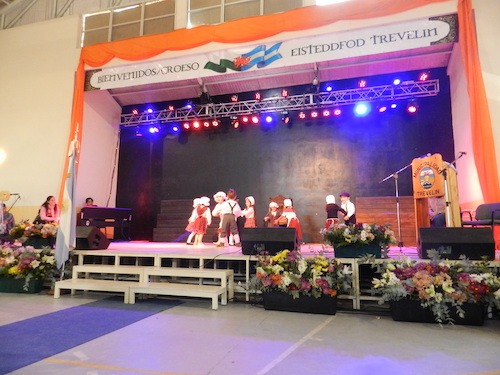 Dawnswyr gwerin bach Ysgol y Cwm yn cystadlu yn yr Eisteddfod eleni. Iago, Aixa, Ambar ac Ailen o Ysgol Gymraeg yr Andes wedi eu llwyddiant yn Eisteddfod Trevelin. | 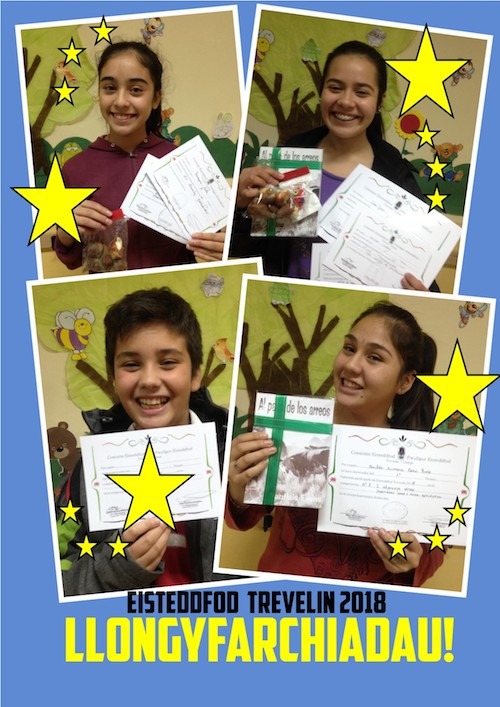 |
Os hoffech chi gystadlu yn Eisteddfod y Wladfa ym mis Hydref eleni, cliciwch ar y ddolen hon:
If you would like to compete in Patagonia’s Eisteddfod this October, click on this link:
eisteddfodpatagonia.com/programa-eisteddfod-del-chubut-2018
ysgolycwm.com / CwmYsgol

